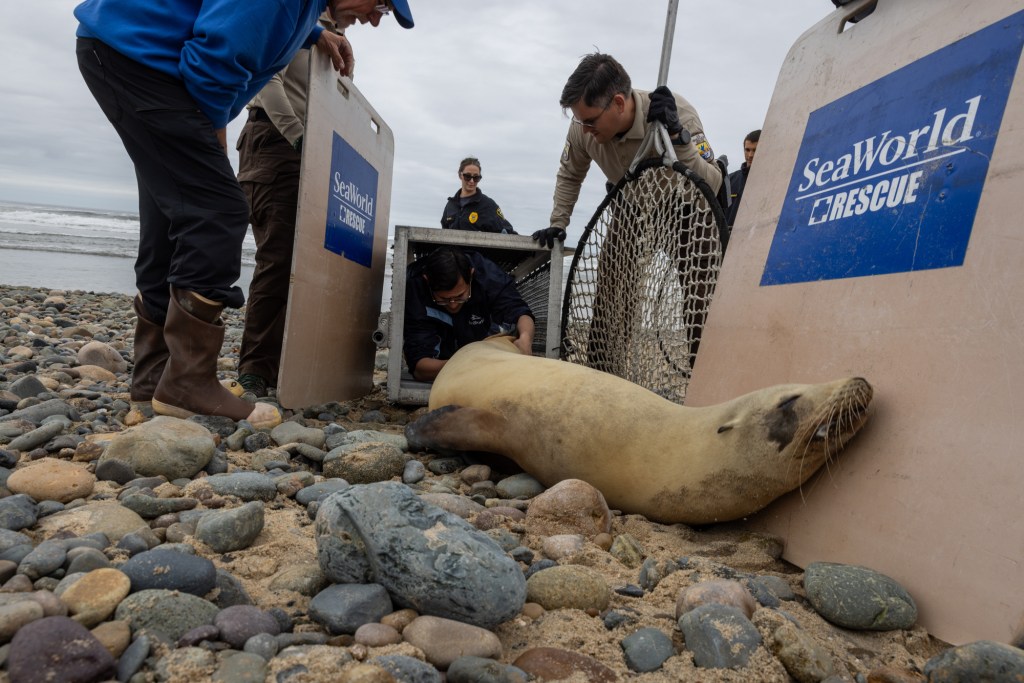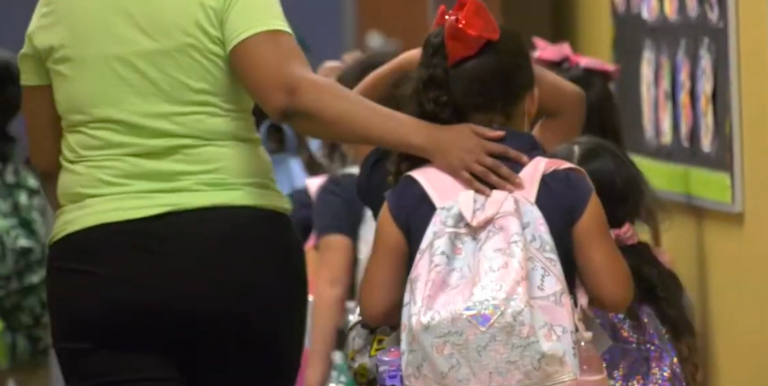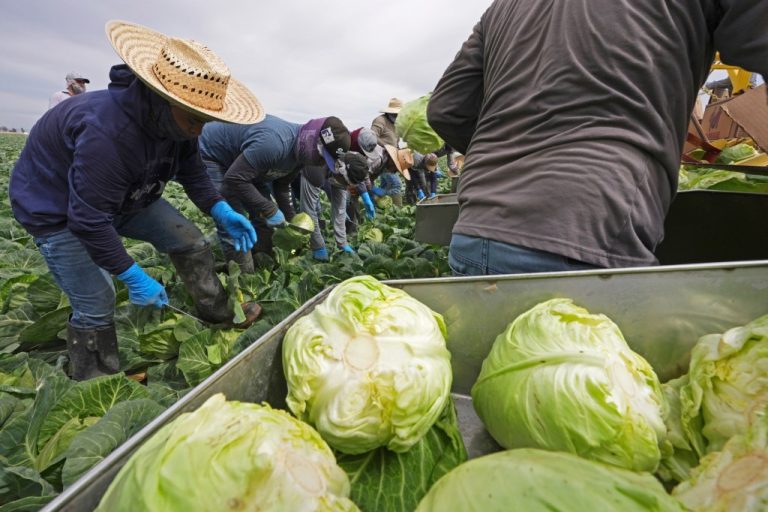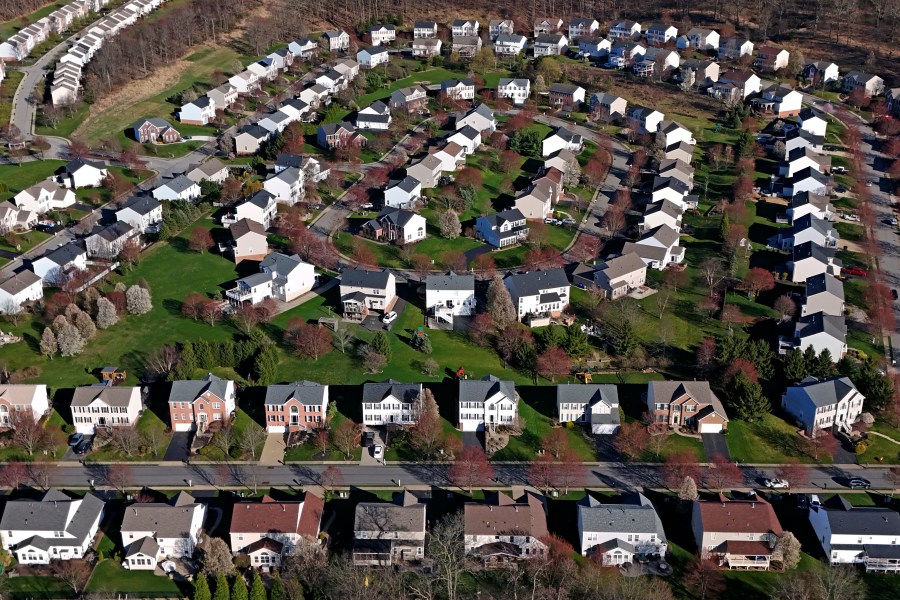
The pregnant sea lion was alone on a rocky shoreline in Imperial Beach. Suffering from a suspected case of domoic acid poisoning, the animal cycled through troubling movements: first, her head would bob and wave; next, her body would shake with seizures; and finally, exhausted, she’d be still.
Despite her issues, she was one of the lucky ones: picked up by SeaWorld animal-rescue workers responding to calls about ailing animals along local beaches. But she was so weak that she had to be pulled into the crate by her flippers.
At the marine park, the animal was examined and given fluids to try to flush the toxins out of her system. But she was in too bad of shape and died a few hours later.
For the past week and a half, the phone has been ringing off the hook at SeaWorld’s rescue program as an algae bloom in coastal waters has caused a surge of sick marine mammals and birds. The park is receiving around 100 calls or emails a day, sometimes repeat calls about the same animal, said park spokesperson Tracy Spahr.

San Diego is just the latest spot along the coast to get hit with a wave of sick animals that began in the Santa Barbara area in February. Scientists say a type of plankton called Pseudo-nitzschia is to blame. It produces a neurotoxin called domoic acid.
When the plankton is consumed, domoic acid can accumulate in shellfish and fish and can damage the brains and hearts of larger mammals that eat the infected food, sometimes causing them to behave aggressively.
As of Friday afternoon, 27 sea lions suspected of domoic acid poisoning had been brought to SeaWorld, up from 11 last year and 18 in 2023. Around half have died. The rest are under the marine park’s care, being treated and monitored with the hope they can recover enough to be released back to the wild.
There have been 10 birds rescued — nine pelicans and one cormorant. The park also was notified about two stricken dolphins, but one of the mammals went back in the water, and the other died as it was being transported, Spahr said.
Many of the sick sea lions being rescued along the coastline are pregnant. It is thought they are more susceptible to the toxin because they tend to eat more food.

The first animal that came into SeaWorld San Diego showing domoic acid poisoning symptoms arrived in mid-February. Over the past 10 days, there’s been a surge of calls.
Some of the animals suffer seizures and tremors, while others seem dazed. SeaWorld staffers will see if the animals respond and become interested in food after being given fluids and medication over several days, said Jeni Smith, curator of the rescue program. Sometimes too much damage is caused. When the animals die, necropsies are done to learn more about what killed them.
Algae blooms are a natural phenomenon and usually occur in spring and summer. The algae can flourish during upwellings, when winds blow from north to south along the coast, pushing water off shore and bringing nutrient-rich deep water up to the surface.
“In any given year, when upwelling happens, any number of plankton can respond. Pseudo-nitzschia is a type of plankton that responds readily to upwelling,” said Clarissa Anderson, a biological oceanographer and harmful algal bloom expert at Scripps Institution of Oceanography at UC San Diego.

Scientists say the algae bloom emerged earlier this year than some previous domoic acid outbreaks and so far has most severely impacted marine animals between Los Angeles and Santa Barbara.
There have been more than 100 dolphins in Southern California affected by the outbreak — far more than in previous events at this point in the year — with at least 50 dolphins stranding along beaches in Santa Barbara and Ventura counties, and eight dolphins dying on San Diego beaches in the past two weeks, according to an update released this week by NOAA Fisheries.
In 2023, more than 1,000 sea lions and more than 100 long-beaked common dolphins died from domoic acid, Anderson said.
In 2015, the largest toxic algae bloom ever recorded caused massive die-offs from Santa Barbara to Alaska, killing thousands of marine mammals, including sea lions and fin whales. This is the fourth year in a row that an algae bloom is affecting Southern California marine life.
“One of the really big predictive difficulties for us is even if we are measuring domoic acid in the water, we can not always say which animals are going to be the ones impacted,” Anderson said. “It just happens to be in the last four years, it has been hitting the California sea lion population much harder than other populations of animals.”
Unlike the previous three years, this year’s event also seems to be impacting sea birds, Anderson said.

She said birds might be affected more because the anchovies and other fish they are feeding on are “hanging out more at the surface.”
With more deaths reported earlier in the year, the outbreak is on track to be severe. “We are just having to watch to see how serious it gets,” said Michael Milstein, a spokesperson for NOAA Fisheries.
For now, officials are warning beachgoers to stay back from ailing animals they find on the beach.
People who see sick or abandoned marine animals are asked to call SeaWorld’s Rescue Hotline at 800-541-7325 or send an email to SWC.Rescue@seaworld.com. Park officials say calls to other phone lines or social media platforms are not monitored by animal care staff and may delay responses.
They asked callers to provide specific information about the animal, including the date and time it was found, and its specific location as well as details about symptoms. In addition, photos and videos can be helpful, Spahr said.
Spahr urged callers to be patient — she said SeaWorld rescue staff are trying to respond as quickly as possible. “The animals are very important to us, and we are trying to get to each of them,” she said.
Staff photojournalist Ana Ramirez contributed to this report.
Originally Published:





